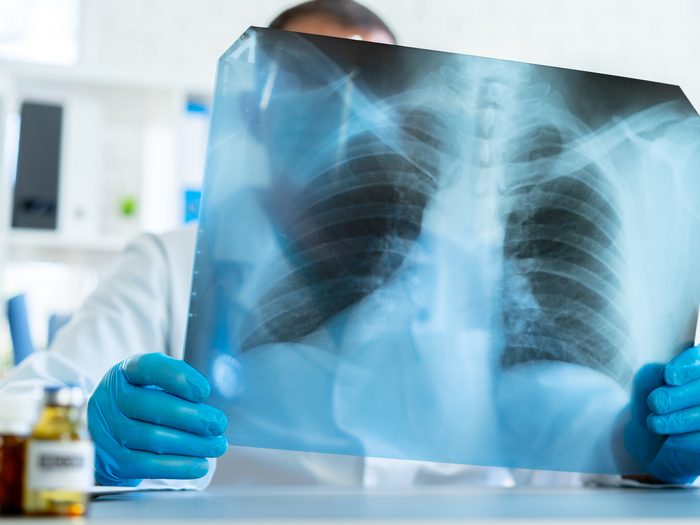Doctors Were Baffled by the Black Spot on This 65-Year-Old’s Lung Scan

Could it somehow be the source of his flu-like symptoms and heart palpitations?
August 2019 was especially damp and foggy in Aylsham, a picturesque town 15 minutes from England’s eastern shores. But Nick Farrow, a semi-retired 65-year-old who works in branding and design, had sunshine on the mind. Along with his partner, her son and his adult daughter, Farrow was about to embark on a week-long vacation to Bali.
Not long before the trip, the family received a series of travel vaccines, including shots for typhoid and hepatitis A and B. Shortly after, Farrow began to experience flu-like symptoms: fatigue, breathing difficulties, aches all over. And at random, his heart would start beating harder and faster than ever, preventing him from falling asleep. “I’d sit there at night, and it felt like there was a bird fluttering in my chest,” he says. The rest of the family, who had received the same immunizations, felt no adverse effects.
Farrow had a history of atrial fibrillation—an irregular heartbeat—but these were new and alarming symptoms, so he arranged to see his GP. By the time the appointment rolled around, the flu symptoms were gone; the nurse he saw surmised that he coincidentally caught a bug around the same time he got the vaccinations. But the heart problems remained, so he was referred to a cardiologist and advised against going to Bali.
When Farrow visited the cardiologist, a number of tests, including a heart ultrasound, chest scan and electrocardiogram, revealed nothing unusual. But before the tests, when the doctor had listened to Farrow’s heart and lungs through his stethoscope, he’d noticed a slight rasp in Farrow’s breathing. He wasn’t sure what that might indicate, so he redirected Farrow to a lung specialist.
A Strange Black Spot
When the results came back from a lung scan in October 2019, they revealed something no one had expected. Nestled behind Farrow’s sternum, in the middle of his chest, there was a strange black spot. It wasn’t on his lungs, nor his heart, but on his thymus. This little known but crucial gland sits between the lungs, just above the heart, and helps develop virus- and infection-fighting T-cells. The thymus remains active only until puberty, at which point it typically begins to shrink, replaced by fat. But in Farrow’s case, it wasn’t reducing in size. It was growing.
The lung specialist had two hypotheses to explain the swelling. It could simply be an enlarged thymus, a benign condition with several possible causes but no serious consequences. Or, if Farrow was unlucky, it could be a thymoma, a rare cancerous tumour that affects fewer than one in 1.5 million people. “It’s really weird when someone tells you you might have cancer. It’s almost unreal,” says Farrow.
The only way to know which theory was correct was a biopsy. But because of the gland’s location, that would require, as Farrow puts it, “Cracking open my ribs and ripping them apart, Viking-style.” Whatever its cause, the growth helped explain his heart issues. The thymus presses up against vital blood vessels and the pericardium (the sac that houses the heart), so a bigger-than-normal gland can result in heart and blood-flow problems like those ailing Farrow. The specialist recommended monitoring the black spot’s progression to determine whether it was cancerous. “It won’t kill you in six months,” he assured Farrow. So they set a follow-up date in April 2020.
Of course, that appointment never happened. Due to the pandemic, Farrow wasn’t able to return for another year, during which time he continued to experience hours-long palpitations about twice a month. “I was getting worried, because I thought this thing was growing inside of me, and I couldn’t get into a hospital,” he says.
Cutting-Edge Technology
Finally, in October 2020, Farrow had another CT scan, which confirmed his worst fears: it was cancer. The black spot had grown two millimetres. Fortunately, the tumour was confined to the thymus, and Farrow’s doctors were confident they could remove it through laparoscopic surgery, which involves inserting minuscule knives into keyholesized incisions.
While Farrow waited for surgery, a colleague introduced him to her husband, Peter Harper, an oncologist who recommended Farrow forgo the laparoscopic surgery and instead come to London Bridge Hospital for robotic surgery. Harper promised it would be more effective and easier on his body.
The machine, produced by an American company called Intuitive, is called the da Vinci Xi surgical system, named after the Renaissance man who advanced the study of anatomy and is credited with inspiring the design of the world’s first robot.
There are nearly 6,000 da Vinci devices in hospitals around the world, used for a wide range of operations, including heart, lung, gallbladder and kidney surgeries. “It’s a rather fierce-looking beast,” says Thomas Routledge, the surgeon who would remove Farrow’s thymus. The machine has two elements: a multi-armed contraption with an arsenal of fine instruments (knives, cameras, clamps) that would hang over Farrow’s bed, and a console that would provide Routledge a 3-D image of the surgical area while he manipulated the device’s arms with foot pedals and a control pad. “It’s not unlike a sophisticated version of a PlayStation controller,” says Routledge, who uses the machine for most of the surgeries he performs.
Over the course of 90 minutes, Routledge removed Farrow’s tumour and a portion of the surrounding thymus; they chose not to remove the entire gland because of the risk of damaging nearby nerves and causing long-term breathing problems. Though Farrow spent that evening recovering in the ICU and a few more days in hospital, he was soon back home and working again. “It stung a bit,” he says, “but in fairness, I felt pretty good.”
Two weeks later, a follow-up scan revealed Farrow was cancer-free. To his relief, the heart palpitations also stopped. Today, Farrow’s life is back to normal. In October 2021, he went on a long-overdue family vacation to the Canary Islands. By then, the surgical scars on his torso were already fading. “No one even noticed them,” he says. “I feel very grateful.”
Next, read the incredible story of how a woman’s x-ray revealed the reason behind a lifetime of stomach pain.






